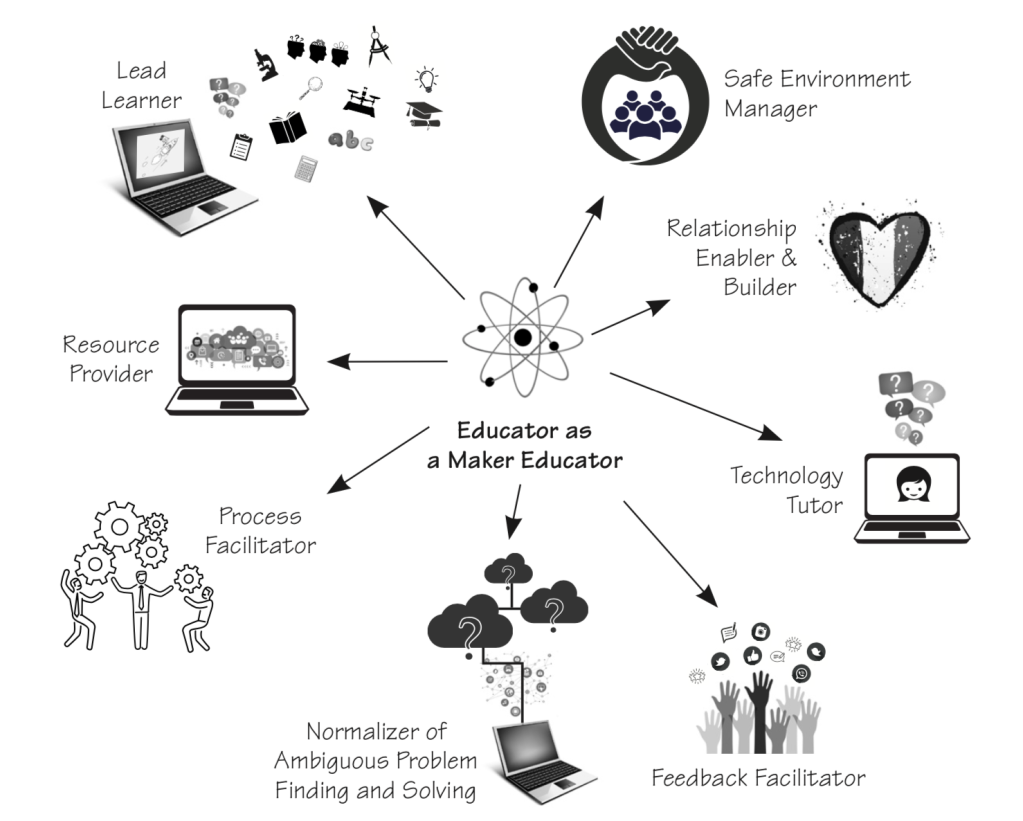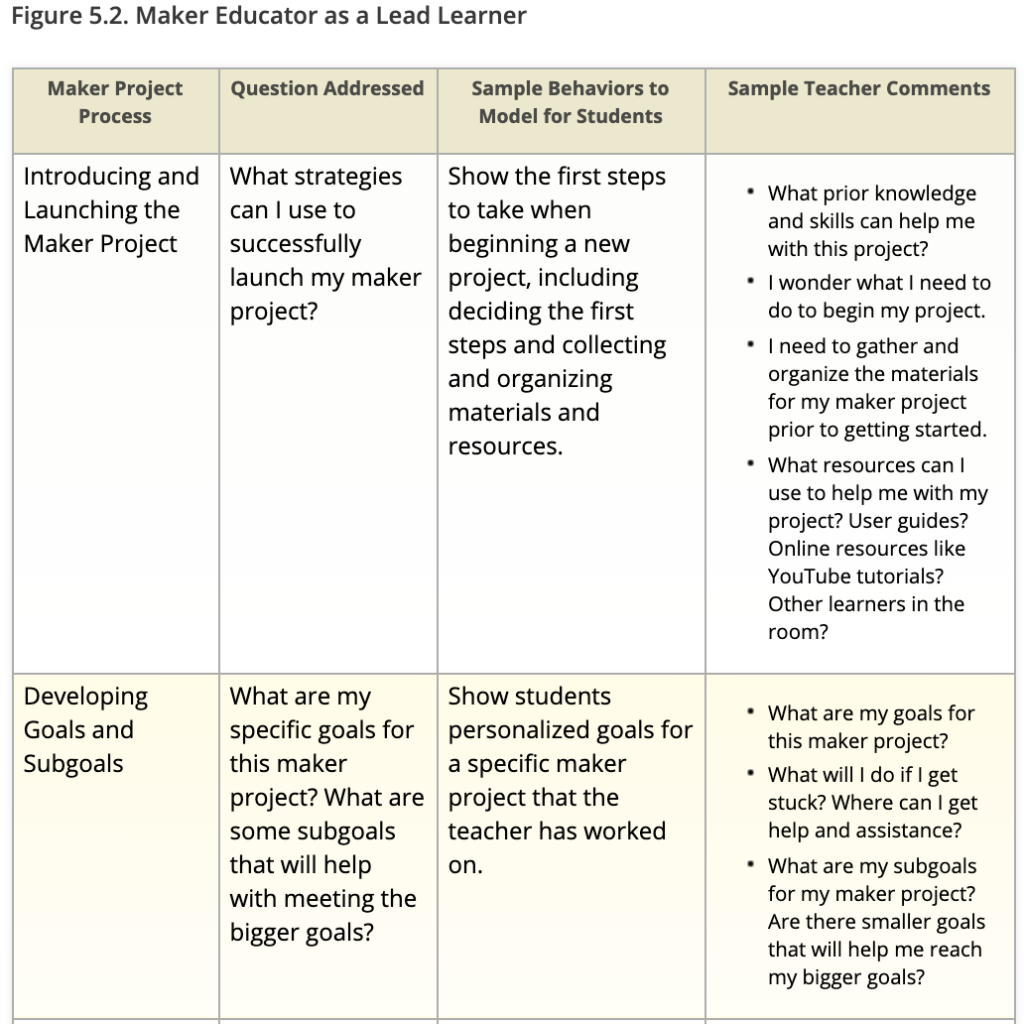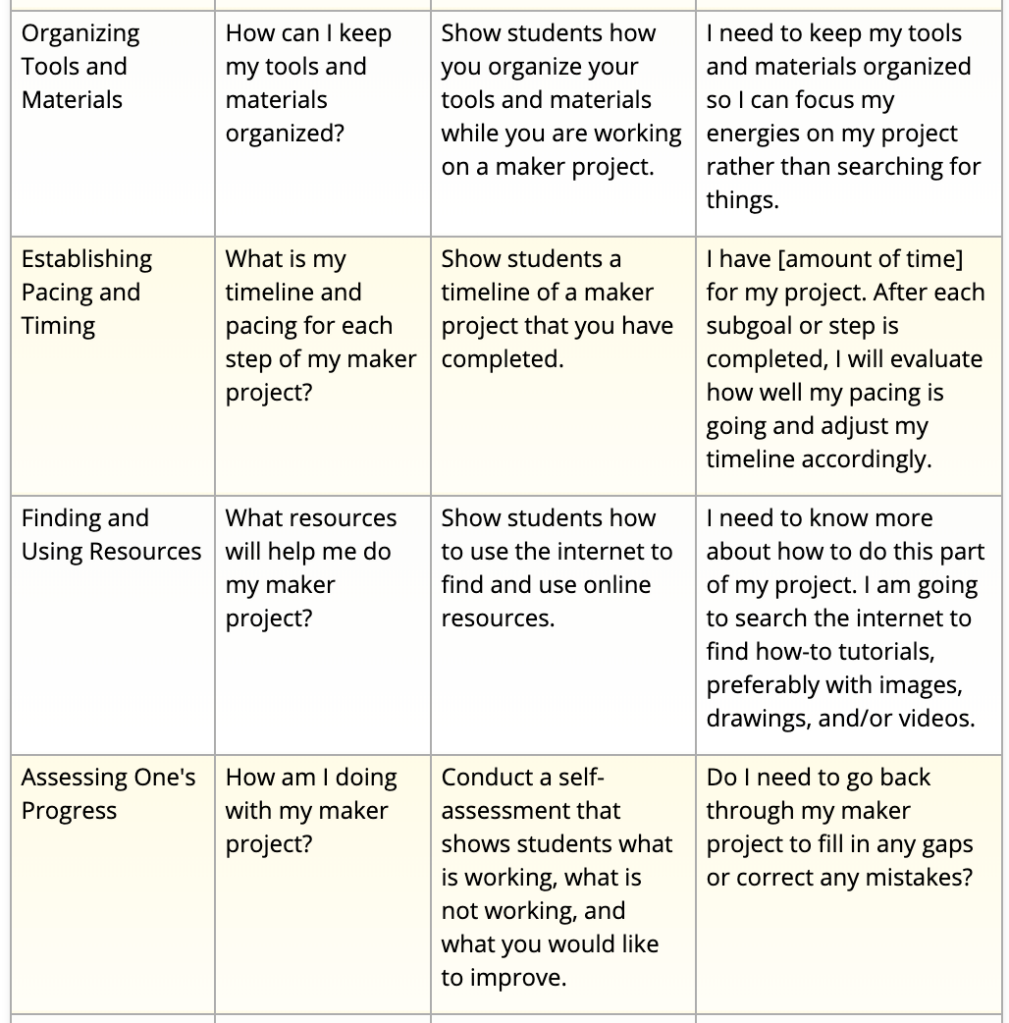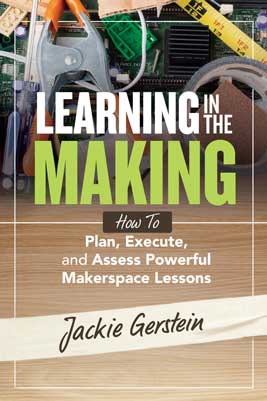Learning in the Making: The Role of the Educator as a Maker Educator
I have been working with ASCD for the past few years to publish my book, Learning in the Making: How to Plan, Execute, and Assess Powerful Makerspace Lessons. It has finally been released for sale! Below is an except – Chapter 5: The Role of the Educator as a Maker Educator.
The process of bringing maker education into formal and informal educational settings involves different approaches and strategies than in a more traditional educational setting. As such, the roles of the educator as a maker educator are also different.
- Lead Learner
- Process Facilitator
- Safe Environment Manager
- Normalizer of Ambiguous Problem Finding and Solving •
- Resource Provider
- Technology Tutor
- Relationship Enabler and Builder
- Feedback Facilitator

Lead Learner
The educator’s role has always been to model and demonstrate effective learning, but somewhere along the line, the educator’s major role became content and knowledge disseminator. Today, content is freely and abundantly available, and it is more important than ever to help learners in the process of how to learn.
In most traditional education settings, the emphasis is on what students “need” to learn, and little emphasis is given to teaching students how they should go about learning the content or what skills will promote robust and effective learning. John Dunlosky, a professor of psychology at Kent State University, stated that “teaching students how to learn is as important as teaching them content, because acquiring both the right learning strategies and background knowledge is important—if not essential—for promoting lifelong learning” (Dunlosky, 2013, p. 13 ).
Because maker education is as much (or even more) about the processes of learning as it is about the products, it becomes important for educators to understand and model the processes— or the “how-to”—of maker education. This often requires teachers to express out loud the metacognitive strategies they use when
In most traditional education settings, the emphasis is on what students “need” to learn, and little emphasis is given to teaching students how they should go about learning the content or what skills will promote robust and effective learning. John Dunlosky, a professor of psychology at Kent State University, stated that “teaching students how to learn is as important as teaching them content, because acquiring both the right learning strategies and background knowledge is important—if not essential—for promot- ing lifelong learning” (Dunlosky, 2013, p. 13 ).
Because maker education is as much (or even more) about the processes of learning as it is about the products, it becomes important for educators to understand and model the processes— or the “how-to”—of maker education. This often requires teachers to express out loud the metacognitive strategies they use when approaching and doing maker activities, including how they learn about the task at hand, find resources, develop an overall goal for the activity, organize and keep track of materials, develop and manage timeframes, and judge their success. Importantly, it also requires teachers to explain what they do when they struggle with a make. This will help learners emulate these learning processes when they work on their own maker projects. Figure 5.2 provides methods and strategies that can be used by the educator to model effective making processes that have the potential to benefit their learners.


If educators embrace the prospect of being a lead learner, then it naturally follows they should be lead innovators, too. Lead inno- vators model eight characteristics of the innovator’s mindset; they are empathetic, problem finders, risk takers, networked, creators, observant, resilient, and reflective (Couros, 2015). “Ultimately, what [innovation] really is about in education is creating new and better ways of learning, which is something educators should all get behind. If I can help more educators see themselves as innova- tors, and help them embrace this mindset, our students will have better opportunities in learning. . . . It is meant to not only help see change as something we embrace and model ourselves but help create the foundation where change is more likely to happen with others” (Larken, 2015, paras. 2, 3).
A common characteristic of making across settings, age levels, socioeconomic backgrounds, and genders is that it is taps into the innovation of the participating learners. When educators model innovation by trying new projects, new teaching procedures, and new technologies, they are not only showing and telling students that innovation is valued in their classrooms but also demonstrating a willingness to take risks often associated with innovation—especially in the sometimes noninnovative environment of traditional schools.
Process Facilitator
Another hallmark of maker education is that the making processes are equally important as the products created. The processes used to make something often carry over to future projects and products. To truly focus on the process—rather than on the products of learning—the educator needs to let go of expectations and preconceived notions about what the specific products students produce “should” look like.
This approach translates into several benefits for learners:
- Learners are not limited by educators’ expectations or the expectations of a lesson or assessment developed by an out- side entity (e.g., textbook or testing company).
- Learners’ engagement, motivation, curiosity, and excitement increase.
- Learners learn to tolerate and embrace ambiguity.
- Natural differentiation and individualization result.
- Learners gain skills such as self-directed learning, taking ini- tiative, locating resources, and asking for help—all of which can be transferred to all learning endeavors.
- It reflects and models how learning occurs outside of school.
- Learners take an increased investment and pride in their work.
- Learners develop both a sense of confidence and a sense of competence.
Safe Environment Manager
An educator’s role as safe environment manager is a two-pronged one. First, teachers must ensure that the learning environment is physically safe. Because a maker environment often contains lots of tools, ranging from scissors and knives to hot glue guns to power tools, the maker educator must establish an environment in which learners’ physical safety is of primary concern. Second, teachers must make sure that learners also feel safe emotionally— that they are willing to take risks and know that their ideas will be accepted and valued by everyone in the classroom. There are some general guidelines for creating a physically safe makerspace. Consider the following as you set up your own maker environment:
- Research how the tools you plan to use in your maker pro- gram operate and the safety procedures associated with them.
- Teach students how to safely use all of the tools in the maker area, including seemingly “simple” tools such as scissors and hot glue guns. Don’t make any assumptions.
- Develop and review procedures about what to do if students notice an unsafe practice or if there is a medical emergency.
- Establish behavioral expectations that students know and understand. These will be guided by the age of your students but can include rules such as no horseplay and keep your hands to yourself.
- Establish, post, and teach clean-up procedures.
More information about creating a physically safe makerspace can be found at https://makezine.com/2013/09/02/safety-in-school-makerspaces/.
Because making often involves taking risks, dealing with failure, asking for help, getting and receiving feedback, and sharing projects with peers, it is important that you also establish a work-learning environment that is emotionally safe for all students. This should be thought out and factored into your maker program from the beginning to develop a healthy sense of community. This can be accomplished through team-building activities with a STEM or maker education focus. Activities such as these help students learn to work collaboratively, communicate, and problem solve with one another. Students also learn to support one another.
As a safe environment manager, teachers should teach and model what emotional safety looks, sounds, and feels like in the learning environment. It then becomes the students’ responsibility to maintain and reinforce that emotional safety. Comments that reflect an emotionally safe and supportive environment include
- “Your effort shows and is admirable.”
- “I like the way you are helping and supporting one another.”
- “Failure is OK; just give it another attempt.”
Students should be acknowledged when they are heard using such comments.
Normalizer of Ambiguous Problem Finding and Solving
Another difference between traditional education and maker
education is that the former too often presents problems that have
a single, correct answer, whereas maker education embraces ill-de-
fined problems that don’t often have obvious or “correct” answers.
Iteration and related failure often accompany maker projects that
are based on ill-defined problems and solutions. Failure often has a
negative connotation in education, but within the maker mindset,
failure is celebrated. Adam Savage, former host of the popular TV
show Mythbusters, often wears a shirt that says, “Failure is always
an option.” Maker educators should normalize iteration and
failure by emphasizing and reemphasizing the idea that ill-defined
and ambiguous problems and solutions are part of the making
process—and real life.
Resource Provider
Because there is so much free information available online, the 21st century educator needs to be a curator of content. As a curator, the maker educator locates and vets resources, especially those that will be used by younger students. These resources can include YouTube videos; tutorials from companies such as Spark- fun, Make: Magazine, Instructables, and Adafruit; relevant books and magazines; social media accounts and hashtags (e.g., #mak- ered, #stem); and online communities, such as Facebook groups. Since the goal is to have learners use self-directed or heutagogical practices, the educator—as a maker educator—should offer resources as suggestions based on individual learners’ projects.
Nevertheless, students should make the final decision about which resources to use and to what degree they want to use them. The educator as a resource provider means that he or she becomes a coach or a mentor to learners. Educators are the adult experts in the room, and learners will often go to the educator for assistance, especially when they get stuck on a problem or need feedback. “The best coaches encourage young people to work hard, keep going when it would be easier to stop, risk making potentially painful errors, try again when they stumble, and learn to love [their learning]” (Tomlinson, 2011, p. 92).
The educator as a resource provider also implies that he or she has multiple skill sets—expertise in the process of learning, exper- tise in how to navigate online environments, and the ability to mentor learners during their maker education experiences. They need to model how to vet the resources and determine their use- fulness and value. They scaffold resource curation and ultimately release responsibility to students as they become more skilled at finding and vetting their own resources.
Technology Tutor
For learner agency and self-directed learning to occur, educators need to keep abreast of current and emerging technologies. There is an assumption that young people are universally digitally savvy and know how to use every form of emerging technology. However, teachers “are increasingly finding that their students’ comfort zone is often limited to social media and internet apps that don’t do much in the way of productivity” (Proffitt, 2012, para. 2).
Technology can dramatically enhance maker experiences since it provides access to resources and tutorials. It also provides a means for learners to share their processes and products. With this in mind, the maker educator can help learners find resources (as previously discussed) and teach them how to use educational technology such as blogs, videos, video creation tools, e-books, podcasts, collages, sketches, and Google apps to document and share their learning.
Relationship Enabler and Builder
Another important hallmark of the maker movement is its strong focus on community. The maker education community, both the in-person and broader global one, is overwhelmingly based on sharing with and learning from one another. Though not every maker shares his or her knowledge or creations, the existence of large online communities shows that many do. People share for various reasons: to exchange information, educate others, get feed- back, and feel connected. This type of collaboration often comes naturally in a making environment, but educators can and should facilitate it through asking—sometimes coaxing—learners to share their ideas, opinions, resources, successes, and failures with other maker learners.
To help facilitate this process, maker educators can ask stu-dents to share what they’ve accomplished so far with their project, where they think things are going in the project, and what issues they have experienced or anticipate experiencing. Students can also document and share their processes and findings in a manner that allows both other students in the class and the larger maker community to review and comment.
Feedback Facilitator
Learners getting feedback on their work is always valuable and important—even more so in the maker environment. Indeed, the maker environment should be rich in feedback. As a feedback facilitator, maker educators not only provide learners with feedback about their maker projects but also teach and facilitate a process for learners to give and receive feedback to one another. Too many educational environments don’t actively teach learners methods and strategies for giving and receiving feedback. Since one of the characteristics of the maker environment is that is it community based, facilitating a feedback process supports and reinforces this sense of community. Because making is often an iterative process, feedback from other community members often facilitates and accelerates that process.
Promises to My Learners as a Maker Educator
Because maker education is so different from traditional education, and because the maker educator’s roles are also so different, I developed the following promises to my learners as a facilitator of their learning as makers:
- I promise to make the making environment positive, joyful, and physically and emotionally safe so you feel safe enough to take risks, ask questions, make mistakes, and test things out.
- I promise to provide you with resources and materials that help you create, make, and innovate.
- I promise to respect and support your unique ways of think- ing, learning, creating, and interacting with others.
- I promise to work with you to create learning experiences that are personally relevant to you.
- I promise to support and help you understand and navigate the ups and downs, the mistakes and failures, and the trials and errors associated with making.
- I promise to give you time and opportunities to collaborate and share with other makers (of all ages).
- I promise to provide you with positive feedback on things you can control—such as effort, strategies, and behaviors.
- I promise to encourage you to critically think, formulate questions of your own, and come up with your own conclusions.
- I promise not to intervene with your learning process unless you ask me to do so.
- I promise to support you as you embrace the joy of creating, playing, innovating, and making.


Hi! Thank you for this post! I like what you say about the roles of educator. Especially it’s interesting about the promises you give to your learners. I wander if you take some promises from them? And how do you present these promises?
And you have a big typo – you wrote tgis paragraph twice “In most traditional education settings…”
nastasi
September 17, 2019 at 1:08 pm
Thank You for sharing such a nice and informative blog and your knowledge with us. In many small group teaching situations, the role of the teacher is that of facilitator of learning: leading discussions, asking open-ended questions, guiding process and task, and enabling active participation of learners and engagement with ideas.
rhea
January 16, 2020 at 9:43 am